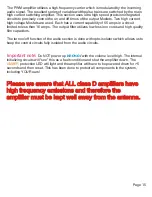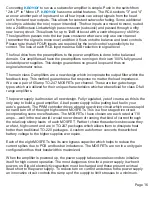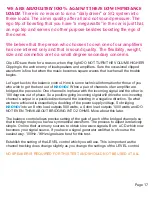
So with these facts established our class A or class B amplifiers channel power supply
energy to the speaker but waste a lot of energy performing this feat.
Class B amplifiers can be made more efficient by using some smart power supply
technology. The “enemy” of the class B amplifier is the value of the power supply voltage
required to deliver the specified output for that particular power.
The technologies available are beyond the scope of this manual but more about this issue
Is available on our website at www.zedaudiocorp on the Techtalk link.
Now back to our class D (not digital) amplifiers. These, as our analog cousins, are again
power supplies BUT with a difference. They are Pulse Width Modulated (PWM) power
supplies whose reference voltage is the incoming analog signal, ie a variable signal being
music or sine waves which changed the width of the pulses. Sounds nice of course but
due to the fact that the PWM operates at a very high frequency of typically greater than
250KHz in full range class D amplifiers, we use a reconstructive filter to remove the
carrier frequency.
I would like to find the people who listen to sine waves. I am still looking! We all listen to
music. Well music is transient in nature and the average signal level varies over quite a
wide dynamic range. Thus our cuddly class D amplifier is NOT being driven at its optimum
Please read this paragraph very carefully. When typical bench testing of amplifiers is
performed we generally use sine waves, a quite severe torture test for almost all
amplifiers. The stress on both the power supply and the actual amplifier is far greater than
with music or speech. Typically any amplifier driven to 1/8th of its absolute clipped power
(1% THD) with sine waves, expends the same energy as music driving the amplifier to
clip occasionally. Easy to verify, We use pink noise (Google it and see what it really is) to
simulate music and this proves, at least to us that pink noise driving the amplifier to clip
occasionally is the same as that 1/8th power deal. What this is all about is that the peak to
average ratio of music is between 10 to 15 percent. In other words your 1,000w brand
spanking new mega Dollar amplifier is only a very good 100 to 150w amplifier which is
capable of musical peaks of 1000 watts ASSUMING that just occasional peaks of the
musical waveform are clipped! You have all been duped over the years by the power
issue. Now I must add this: When playing certain types of music there are times where the
musical signal is remarkably similar to those brute force sine waves us engineers like to
use for testing. Pipe organ music, of which I am a fan is one of these. A sustained organ
note drives the amplifier much harder than typical music almost like a sine wave.
Now for another “bombshell”. Class D amplifiers are NOT 90+% efficient as advertised by
pretty much all companies who tout their wares. A well designed class D amplifier will be
90+% efficient based on two conditions. First that the amplifier is driven into some
optimum impedance (typically greater than 2 ohms) and secondly that the amplifier be
driven with a sine wave at just below clipping (typically 1% THD). Mmmmmm well this
now opens a new can of worms, does it not?
Now for another “bombshell”. Class D amplifiers are NOT 90+% efficient as advertised by
pretty much all companies who tout their wares. A well designed class D amplifier will be
90+% efficient based on two conditions. First that the amplifier is driven into some
optimum impedance (typically greater than 2 ohms) and secondly that the amplifier be
driven with a sine wave at just below clipping (typically 1% THD). Mmmmmm well this
now opens a new can of worms, does it not?
Page 2





































